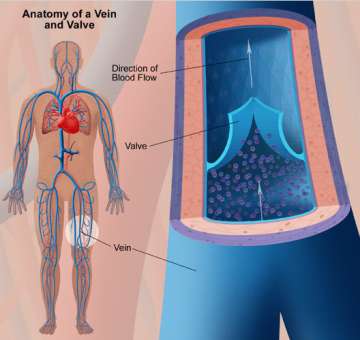Chronic Venous Insufficiency
Find your care
We offer a full range of vein treatments, including ones developed at UCLA Health. Call 310-206-6294 to learn more about our services.
What is chronic venous insufficiency, and what causes it?
Chronic venous insufficiency (CVI) is a condition caused by poor function of the veins of the legs. This causes the blood to back up and damage the tissues of the legs. It can be caused by leaky valves in the veins, which prevents the return of blood from the legs to the heart or by an obstruction in the veins due to repeated clots or bouts of inflammation. The back up of blood into the legs causes the legs to swell (edema) and take on a brownish tone. The tissue can also become hard (lipodermatoclerosis) and, in severe situations, ulcers can develop. CVI can be diagnosed by venous ultrasound (duplex), phethymography or, less frequently, by injecting contrast into the veins and taking x-rays (venogram).

What are venous ulcers?
Venous ulcers are ulcers on the leg caused by CVI. This happens because the back-up of blood prevents fresh blood with oxygen and nutrients from reaching the skin. When the skin is injured with a minor scratch or trauma, the skin can break down and form an ulcer. These usually occur on the inside of the leg, a few inches above the ankle, in the "gaiter" zone. Because fresh blood is prevented from reaching the skin, these ulcers are very slow to heal.
How can you treat venous stasis ulcers?
A majority of venous stasis ulcers can be treated with elastic compression stockings. In severe cases, a special dressing can be applied that can be wrapped around the leg and foot to compress the veins and prevent swelling of the ankle. It is changed every week until the ulcer has healed. Medicated dressings can be placed directly on the wound to speed up healing - you should be sure to go to a center with these medicated dressings available and the expertise in wound care to achieve the most rapid healing.
How can you prevent venous ulcers?

Once the ulcers heal, the patient needs to wear graduated support stockings to prevent leg swelling. Walking and exercise of the legs are also important to help pump blood out of the leg and further reduce swelling. These measures will help to keep blood from backing up in the legs and prevent the formation of ulcers. Unfortunately, 70% of patients with venous ulcers have a recurrence within a year, unless they have their incompetent veins treated.
Is surgery ever indicated for CVI?
Although conservation therapy with compression and support hose is used to both prevent ulcers and treat them initially, all patients who have had a venous ulcer should have a duplex ultrasound to look for insufficiency of the large veins or perforator veins. When insufficient veins with reflux are found, simple ambulatory procedures can often be done to significantly reduce the likelihood of recurrence of the ulcers.
Visit our health library to learn more about chronic venous insufficiency.
Contact us to schedule an appointment.